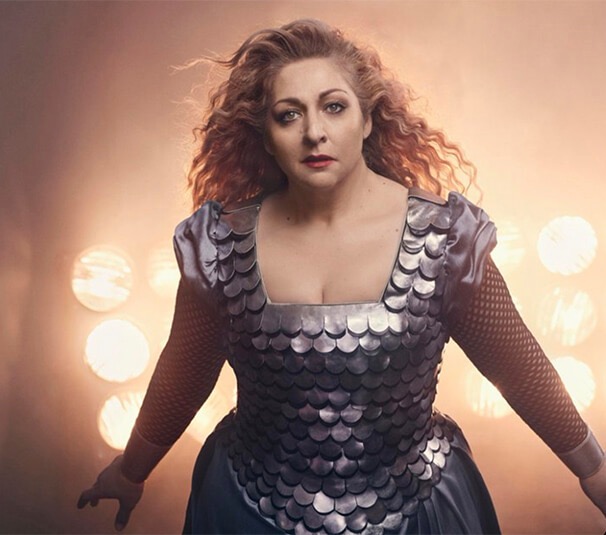Music of Wagner returns in style to Baltimore Symphony with Conlon, Goerke

Soprano Christine Goerke sang excerpts from Wagner’s Die Walküre with James Conlon and the Baltimore Symphony Orchestra Thursday night. Photo: Metropolitan Opera
James Conlon is at the midpoint of his first season as artistic advisor to the Baltimore Symphony Orchestra. The major event of his tenure so far came on Thursday night, a splendid Wagner-centered evening with two of the leading Wagner singers of our day at Meyerhoff Symphony Hall.
Beethoven’s Eighth Symphony introduced excerpts from Die Walküre, and Conlon’s decisive ideas in both works seemed to catch the orchestra off guard.
This is not necessarily a bad thing. The musicians are getting to know the conductor, and that process can—perhaps should—involve some jostling of familiar patterns. The Beethoven opened slightly off-kilter, with Conlon moving faster than the orchestra may have expected, a gambit that injected some unpredictable urgency into the score. A broad rallentando on the second theme expanded the rhythmic freedom in the other direction.
Conlon helped the musicians sculpt firm contrasts between loud and soft dynamics in the development. Peak excitement arrived as the pedal point at the end of the development built up to the return of the main theme, now placed in the cello section. Beethoven recreates this moment on a smaller scale in the first movement’s coda, with the clarinet playing coyly around the main theme.
The two middle movements were much more amiable and relaxed. Gentle, detached woodwinds and horns punctuated the second movement, like a wind band keeping pace with the strings. Stretching of the upbeat added a weighted, folksy touch to the third movement, set at a loping pace, with fine solo work in bassoon and trumpets. The trio combined rustic horns and clarinet over an active cello accompaniment.
Brisk pacing enlivened the crisp finale, in which Beethoven breaks down the insistent main theme into its component parts, as if in a blender. The triplets on a repeated note, the first part of that melody, came off with machine-gun intensity in the strings. Towards the end the cello section dramatically hammered the second part of the tune, as if to cut off all further development, before the piece bubbled to its buoyant conclusion.
This season has offered, one by one, a gradual return to musical experiences taken away during the coronavirus pandemic. The chance to hear a vast Wagnerian orchestra was the latest delight in this process.
In the second half, Conlon led an orchestral arrangement of “The Ride of the Valkyries,” from the third act of Die Walküre, that was merged with no pause into the final scene from that act, the anguished father-daughter duet of Wotan and Brünnhilde.
Conlon’s tempo made for a swift “Ride,” capturing the exciting scene brilliantly even without the voices of the Valkyries. The strings and woodwinds soared and trilled vividly, while the brass section provided crushing power, including bass trumpet and tuba, with Conlon marshaling explosive climaxes. As the sound washed over one’s ears—so much more thrilling live than it can ever be in a recording—emotions surged at the thought of music’s triumphal return.
Christine Goerke, who made a last-minute substitution as Brünnhilde in this opera to save the first Ring cycle at Washington National Opera in 2016, was again sensational in the role. Her chest voice boomed powerfully, down to the A sharp below the staff, and she was fearless in the heights. The high A’s in her final lines, as she faces down Wotan’s anger, gleamed with vitality.
Bass-baritone Greer Grimsley remains a potent Wotan, although his tone has grown a bit woolly, due to a sometimes pronounced vibrato. The lower range retained the greatest force, while some of the top notes paled under the weight of the full orchestra. Like Goerke, Grimsley knows this role from long experience and brought out many salient details. When the two singers walked to the central stage, behind Conlon’s podium, the embrace of father and daughter was moving.
Conlon, who led the first Ring cycle ever at Los Angeles Opera, gave equally expert shape to the crucial orchestral part, which in Wagner’s hands often reveals the psychological complications of the story. Principal oboist Katherine Needleman brought out the Leitmotif signifying Brünnhilde’s love greeting with poignant clarity. Wagner interweaves this theme constantly with the melody indicating the frustration of Wotan’s will, the two conflicting forces in this scene.
Again the brass section dominated the loud textures, often on themes that Wagner associated with unavoidable destiny, in a surging three-chord sequence, the “Ride of the Valkyries,” and the unmovable power of Wotan’s spear. The curse theme and the Leitmotif representing the heroism of Siegfried also came out clearly, even though at this point in the cycle Siegfried exists only as an embryo. In a brilliant bit of foreshadowing, the orchestra tells us that he will rescue the Valkyrie from the forbidding wall of fire summoned around her at Wotan’s command.
The program will be repeated 8 p.m. Friday and 3 p.m. Sunday at Meyerhoff Symphony Hall, and 8 p.m. Saturday at Strathmore. bsomusic.org


